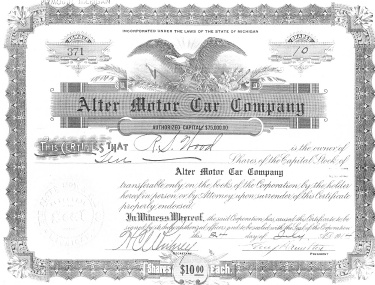The Company

In 1914 a group of Detroit businessmen headed by Guy Hamilton and F.M. Woodward set out to form an automobile manufacturing company. Their intent was to produce a low cost vehicle to compete with Henry Ford's wildly successful Model T. They opened an office on Grand River Avenue in Detroit and began evaluating designs. They settled on a design by Clarence Alter of Manitowoc, Wisconsin. The first Alter was to be a five passenger touring car with a 22 1/2 horsepower four cylinder engine and a 106 inch wheelbase.
The company approached officials in Plymouth, Michigan,west of Detroit, about raising $5,000 in local capital to locate the factory there. After sending a committee to Detroit to evaluate a prototype of the car, Plymouth's Village President, Louis Hillmmer, agreed to the deal. Many Plymouth residents invested, and construction of the factory buildings began on Farmer Street. Alter was promised free title to the land if the venture was a success.
The location was adjacent to railroad tracks, critical to Alter's strategy of assembling the car from purchased components. Plymouth was known as the air rifle capital of the world, as it was home to both the Daisy and the Markham air rifle. Production began immediately, and Alter produced its first 10 cars in July of 1914.
The Alter was a hit, and the company soon had 100 employees and was producing 25 cars a day. A roadster was added to the line in 1915. But success was to lead to Alter's downfall, as demand quickly surpassed the company's ability to produce. Ford's phenomenal success was largely do to its ability to mass produce vehicles. If Alter was to remain in the game, they would have to expand, and fast.
Expansion almost happened when in July of 1916 the town of Grand Haven on the west side of Michigan expressed an interest in helping Alter relocate to larger facilities there. The reorganized company was to be called the Hamilton Motors Corporation, after Alter president Guy Hamilton. The car was to be named the Hamilton. Ground was broken on a new factory and plans were made to hire 200 workers. But time and money ran out before the deal could be completed, and on January 5, 1917 the directors of the Alter Motor Car Company voted to dissolve the company. With $40,000 in assets $20,000 in debts, Alter went into receivership and closed its doors.
Hamilton Motors did eventually get off the ground without Alter, and produced trucks, not cars, through 1922.